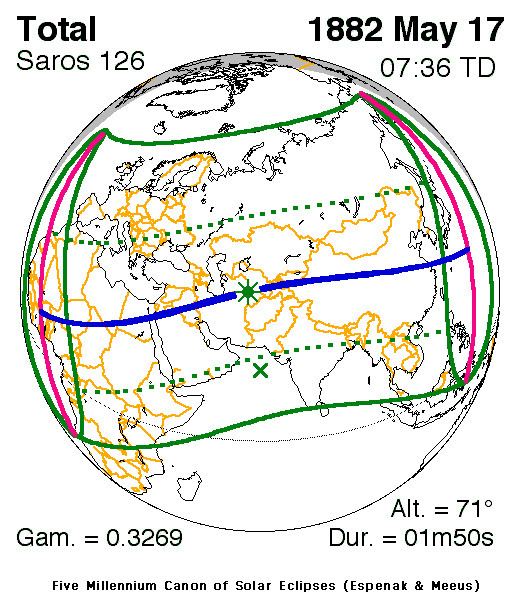Nature Total Magnitude 1.02 Max. width of band 72 km (45 mi) Start date May 17, 1882 | Gamma 0.3269 Duration 110 sec (1 m 50 s) Greatest eclipse 7:36:27 | |
 | ||
A total solar eclipse occurred on May 17, 1882. A solar eclipse occurs when the Moon passes between Earth and the Sun, thereby totally or partly obscuring the image of the Sun for a viewer on Earth. A total solar eclipse occurs when the Moon's apparent diameter is larger than the Sun's, blocking all direct sunlight, turning day into darkness. Totality occurs in a narrow path across Earth's surface, with the partial solar eclipse visible over a surrounding region thousands of kilometres wide. Totality was visible across central Africa, the Middle East, and southeastern Asia.
Contents
Observations
A party of observers gathered in Egypt to watch the eclipse were greatly surprised when they observed a bright streak near to the Sun once totality began. By a remarkable coincidence, the eclipse had coincided with the perihelion passage of a Kreutz comet. The comet would otherwise have gone unnoticed — its sighting during the eclipse was the only observation of it. Photographs of the eclipse revealed that the comet had moved noticeably during the 1m50s eclipse, as would be expected for a comet racing past the Sun at almost 500 km/s. The comet is sometimes referred to as Tewfik, after Tewfik Pasha, the Khedive of Egypt at the time.
Saros 126
It is a part of Saros cycle 126, repeating every 18 years, 11 days, containing 71 events. The series started with partial solar eclipse on March 10, 1179. It contains annular eclipses from June 4, 1323 through April 4, 1810 and hybrid eclipses from April 14, 1828 through May 6, 1864. It contains total eclipses from May 17, 1882 through August 23, 2044. The series ends at member 72 as a partial eclipse on May 3, 2459. The longest duration of central eclipse (annular or total) was 5 minutes, 46 seconds of annularity on November 22, 1593. The longest duration of totality was 2 minutes, 36 seconds on July 10, 1972.
